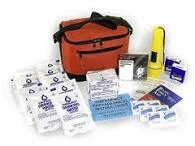Tips on How You Can Self-sustain for 72 Hours in an Emergency
 A great deal of time must pass before the city of Atlanta will be able to put behind it the chaos that took place due to the snow and ice storm of February 2014. Atlanta native, Allison Bailey agrees. She was one of thousands of motorists who were directly affected by the storm. “I had to pull over on the side of the road with my twin 2-year-old boys. All I had to give them was gum and they had to split one juice box. I was thankful when I finally got home right after midnight, but it was probably one of the worst experiences that I have ever had. I really wish the city had been more prepared for what came our way.” She said.
A great deal of time must pass before the city of Atlanta will be able to put behind it the chaos that took place due to the snow and ice storm of February 2014. Atlanta native, Allison Bailey agrees. She was one of thousands of motorists who were directly affected by the storm. “I had to pull over on the side of the road with my twin 2-year-old boys. All I had to give them was gum and they had to split one juice box. I was thankful when I finally got home right after midnight, but it was probably one of the worst experiences that I have ever had. I really wish the city had been more prepared for what came our way.” She said.
Allison is correct, the main lesson that we can learn from that hectic day is that preparation is key. This is especially true if we are to prevent history from repeating itself. But, let’s face it. If you asked your friends and family whether or not they have an emergency kit in their car, do you believe many would actually say yes? Even better, could you be self-sustained for at least 72 hours during an emergency?
Most people are so busy with life that they neglect to make time to plan for the inevitable. In fact, most people don’t think about emergencies until they are in the midst of them. Unfortunately, by that time, it is far too late.
Mark Hoots opened his Smyrna, GA based store Going Gear, in July 2008. His mission was to provide survival tools and resources to be used in the event of an emergency. Mark believes that some people have the wrong idea about being a survivalist. “Some people think that survivalist preparation is about preparing for a dooms day event or some type of apocalypse. But, if you can see from what happened right here in Atlanta, it is really about whether or not you have the key essentials needed in order to sustain yourself during the most difficult emergency situations.” Mark said.
Mark hosted a special event at his store recently. He invited the community in and showed them how to build a go bag. “A go bag is a bag filled with items that could help you during an emergency. You can look at it like an emergency kit. “He said.
Mark had YouTube sensation and fellow survivalist, Scootch present at the event. Scootch was there presenting seminars on the types of items that would go into an effective go bag. Scootch says that the go bag is a very important component to surviving during an emergency. “ When building the bag, you should be thinking about things that you need at your disposal in the event of any emergency. Being prepared for the events that happen in life is very important and having a go bag is an aspect of this preparation. A go bag is something personal and it’s something that you need in order to sustain your life.” He said.
Even if you are fortunate enough to never encounter a catastrophic event during your lifetime, it’s still a smart decision to prepare for the worst. The following are essential items that you can have in your go bag and they will help you to do just that:
1. Water: This is the most basic necessity. Store enough water to last for at least three days, which equals 1 gallon per person, per day. Water is especially important if you live in a warm climate or have children.
2. Food: Keep a three-day supply of non-perishable food on hand. Stock up on staples and canned goods that don’t require refrigeration, cooking or water. A manual can opener is also a must.
3. Whistle: A great way to signal for help and can serve as security.
4. Battery-powered or hand -cranked radio: The best way to stay informed and track inclement weather. Be sure to buy extra batteries.
5. First aid kit: Should include sterile gloves, sterile dressings, soap, antibiotic ointment, bandages, eye wash, a thermometer and prescription medications. Ready.gov also recommends over-the-counter pain relievers, antidiarrheal medication, antacids and laxatives.
6. Hygiene and sanitation supplies: Hand wipes, garbage bags, toilet paper and plastic ties can help keep you and your shelter clean.
7. Wrench or pliers: You never know when these multipurpose tools will come in handy.
8. Local maps: Learn different routes out of town in case some roads are closed because of traffic or others hazards.
9. Cell phone with chargers: Keep in contact with loved ones, emergency personnel or rescuers.
10. Extra clothing: pack a jacket, hats, mittens, scarves and one warm blanket or sleeping bag per person and an extra pair of tennis shoes really come in handy.

